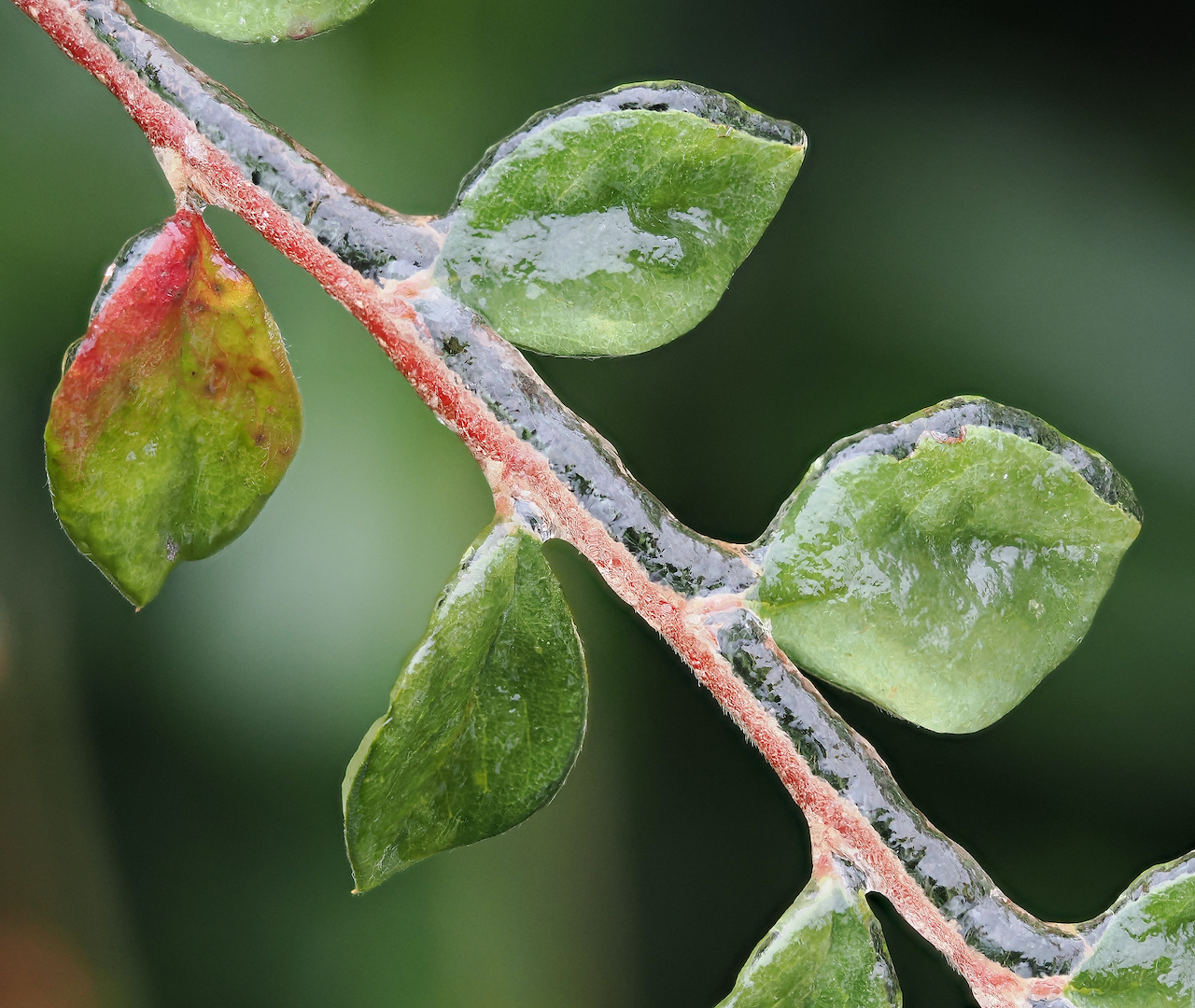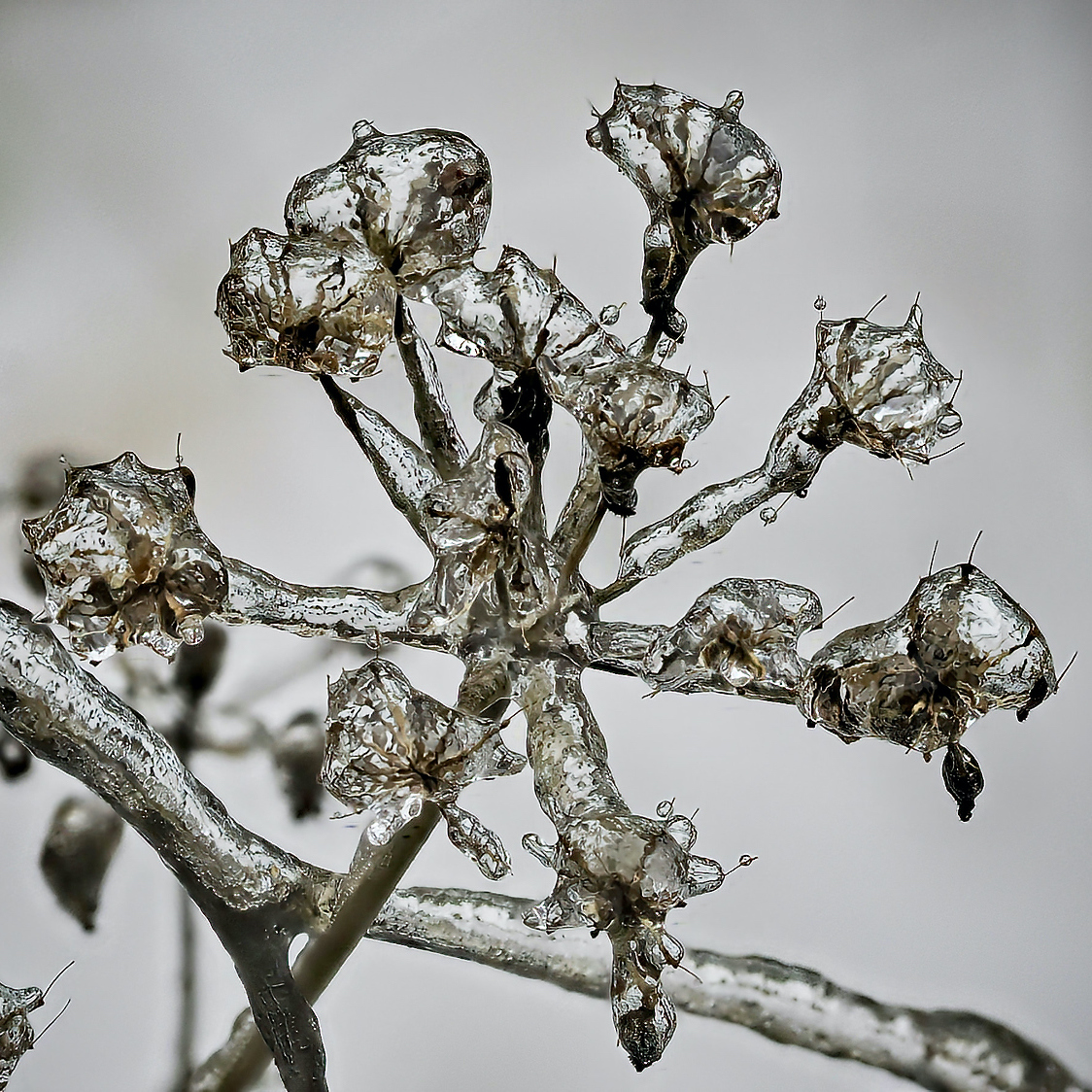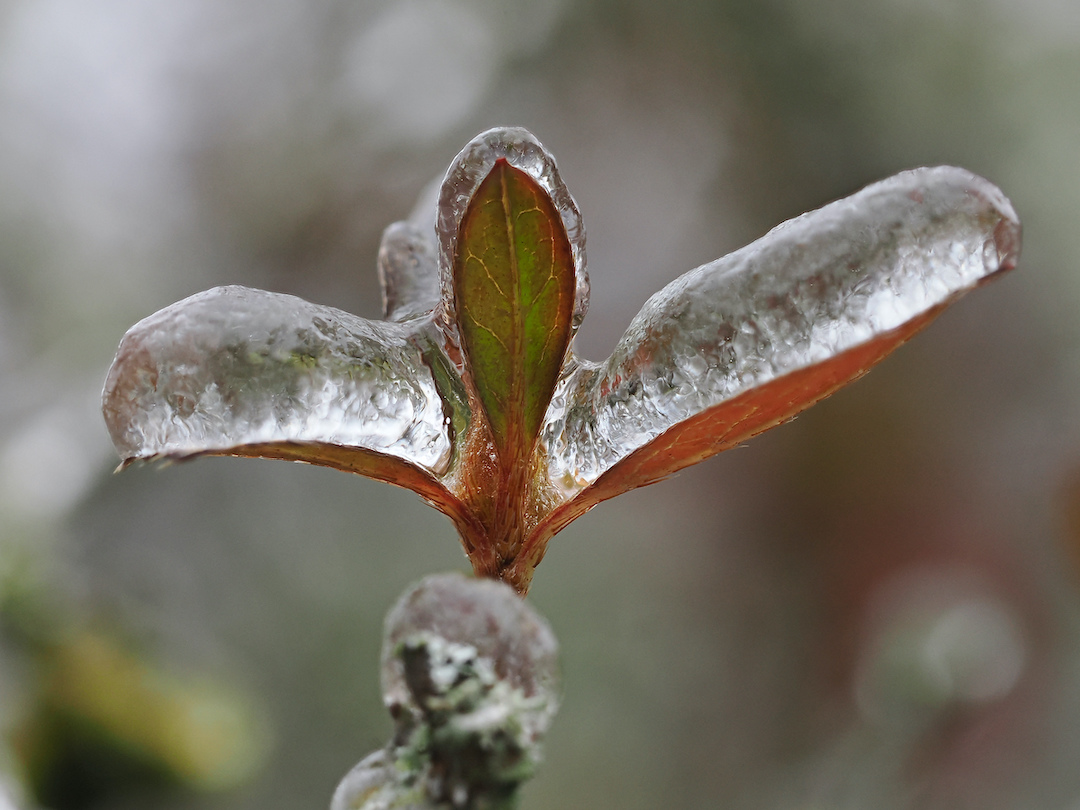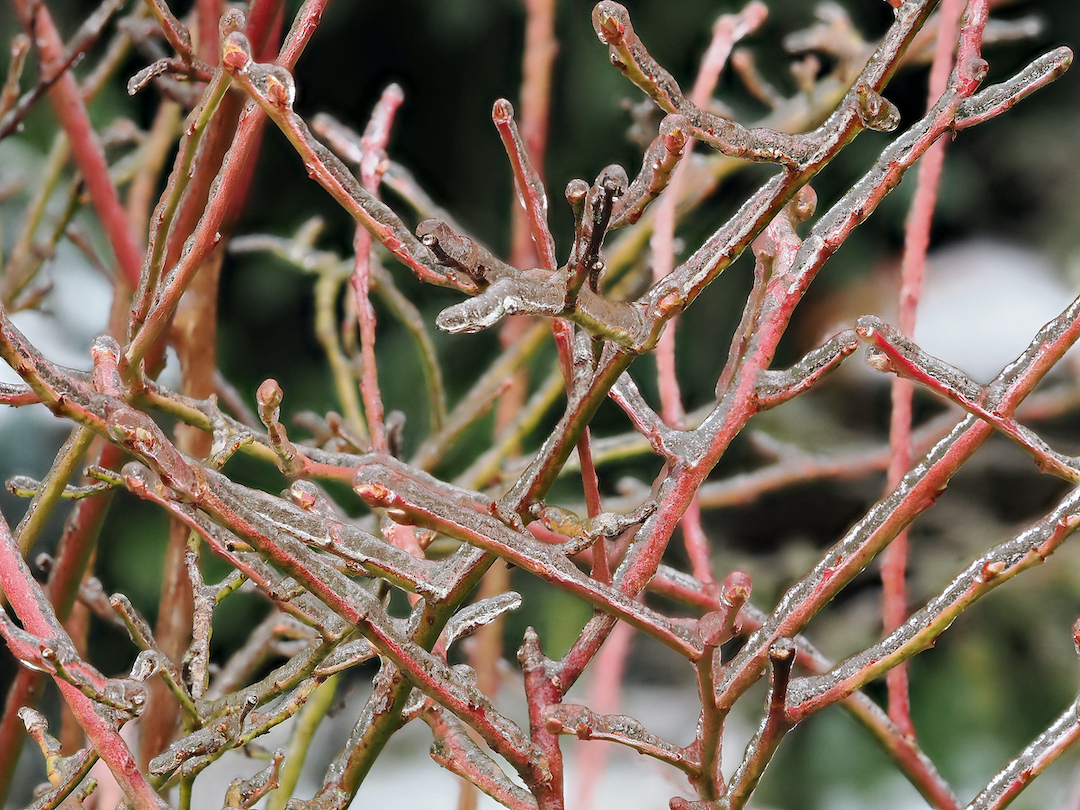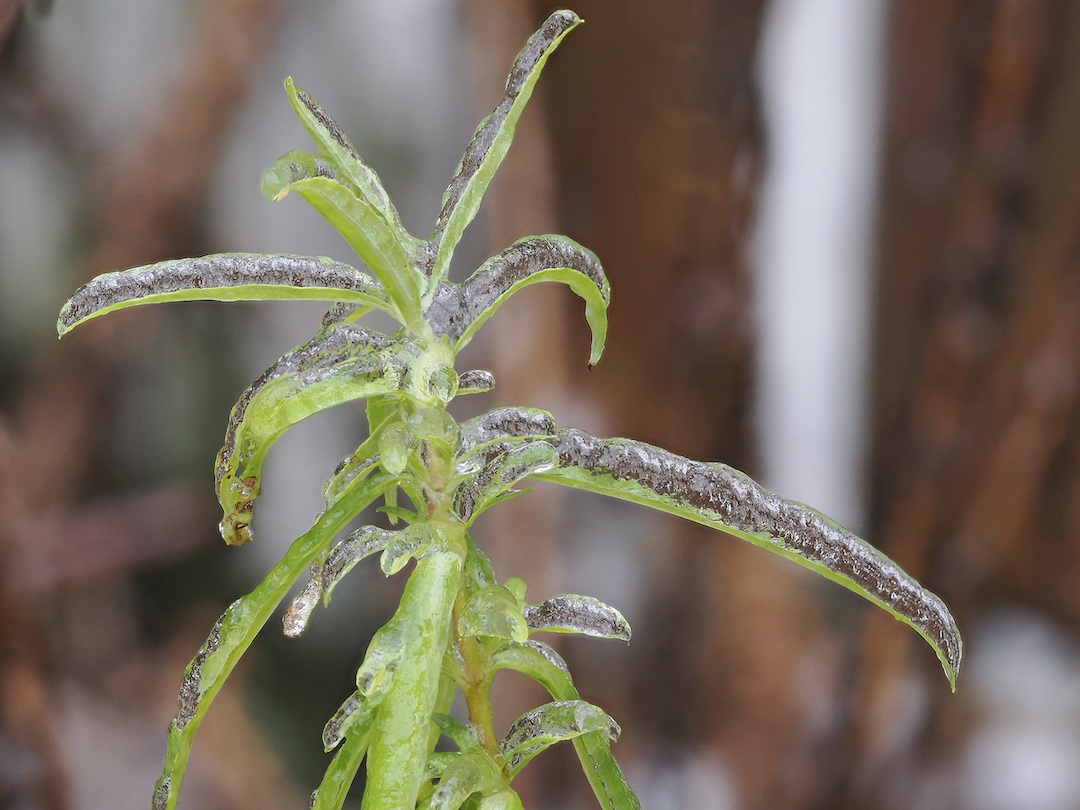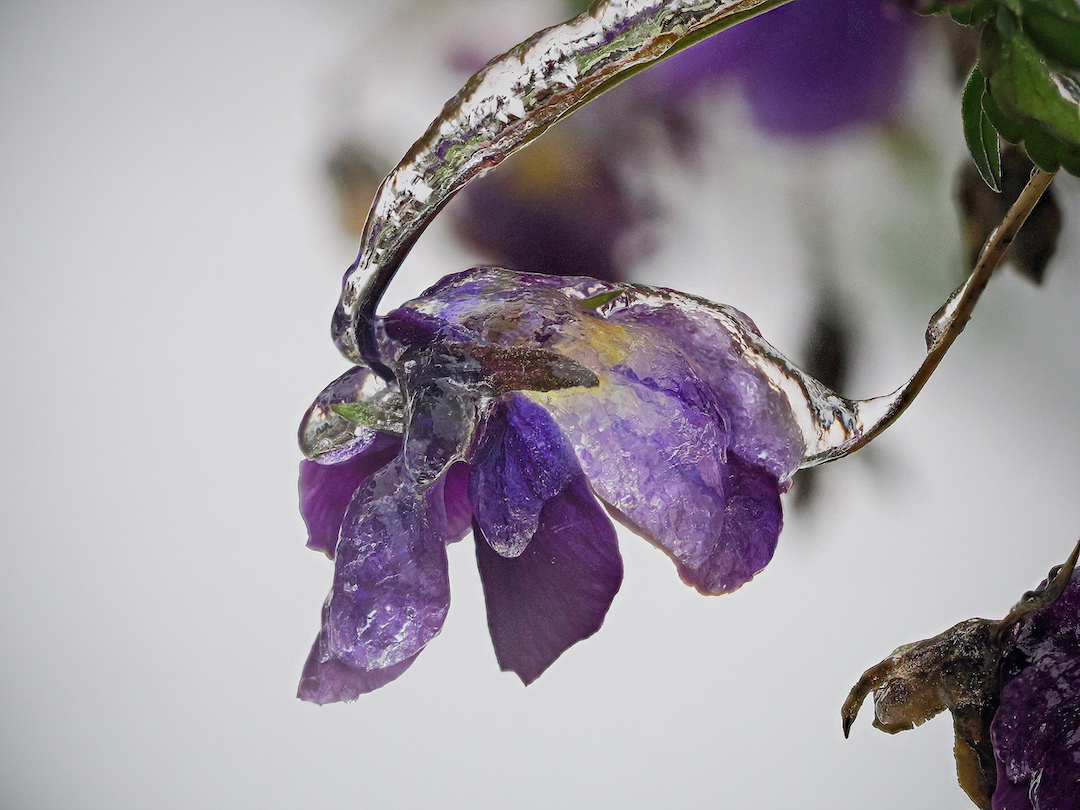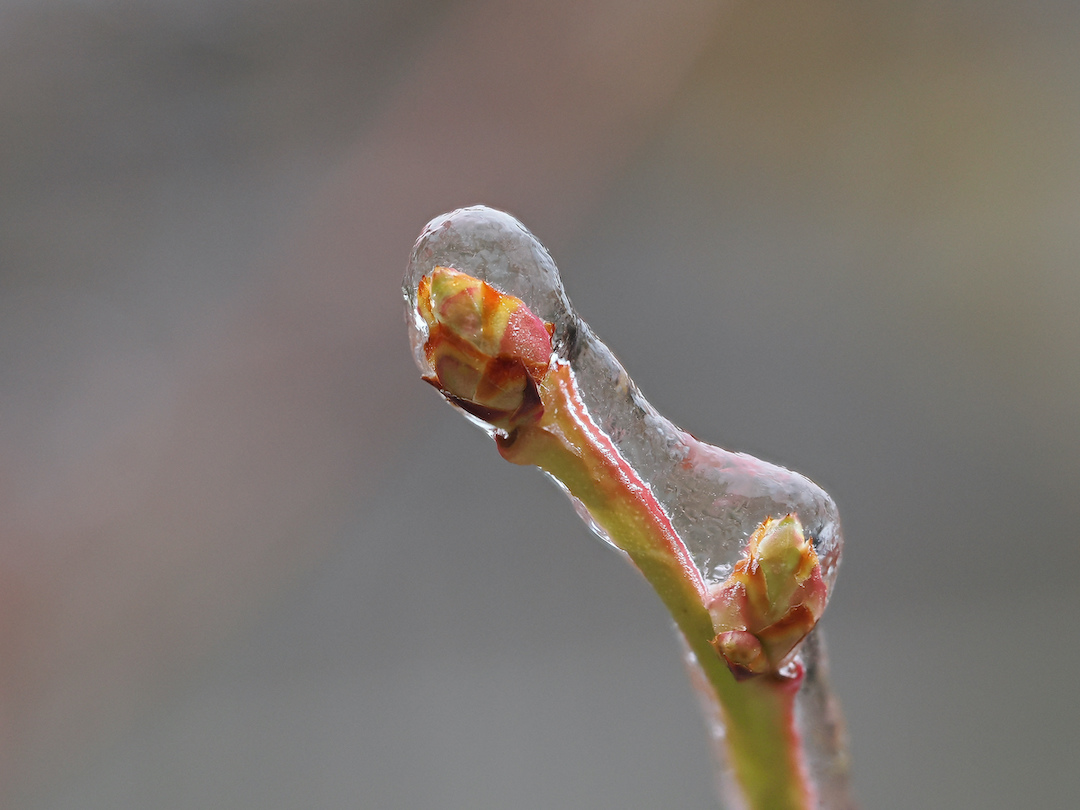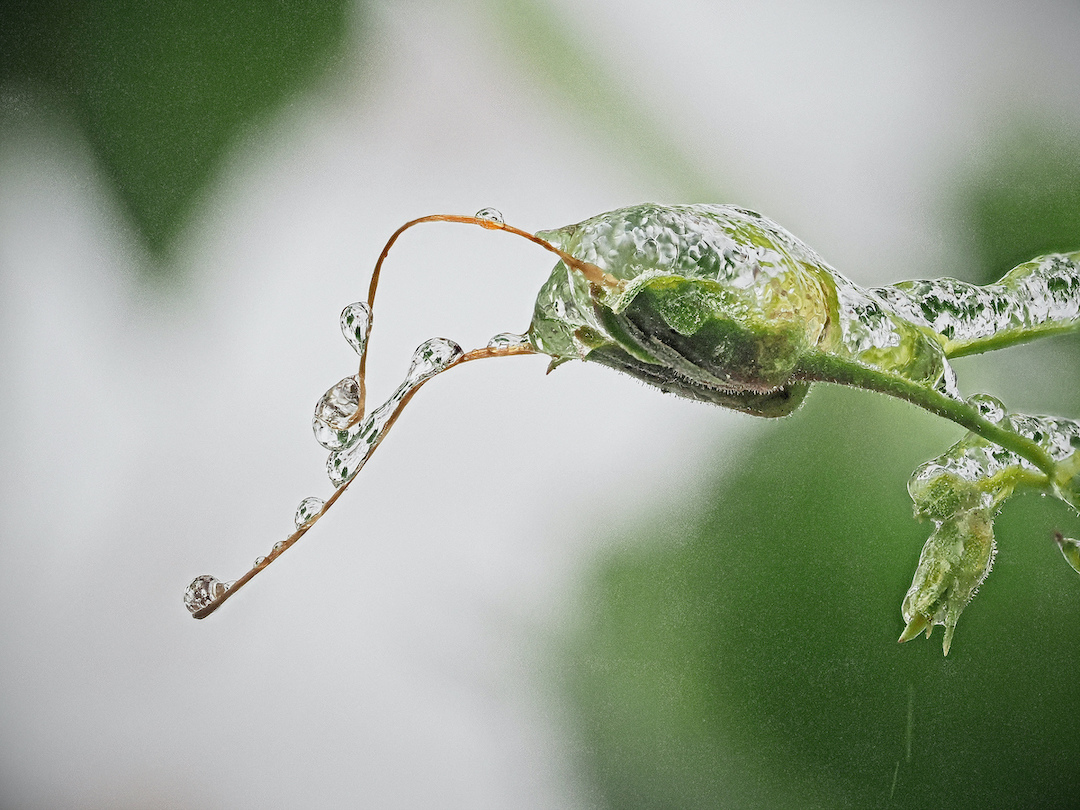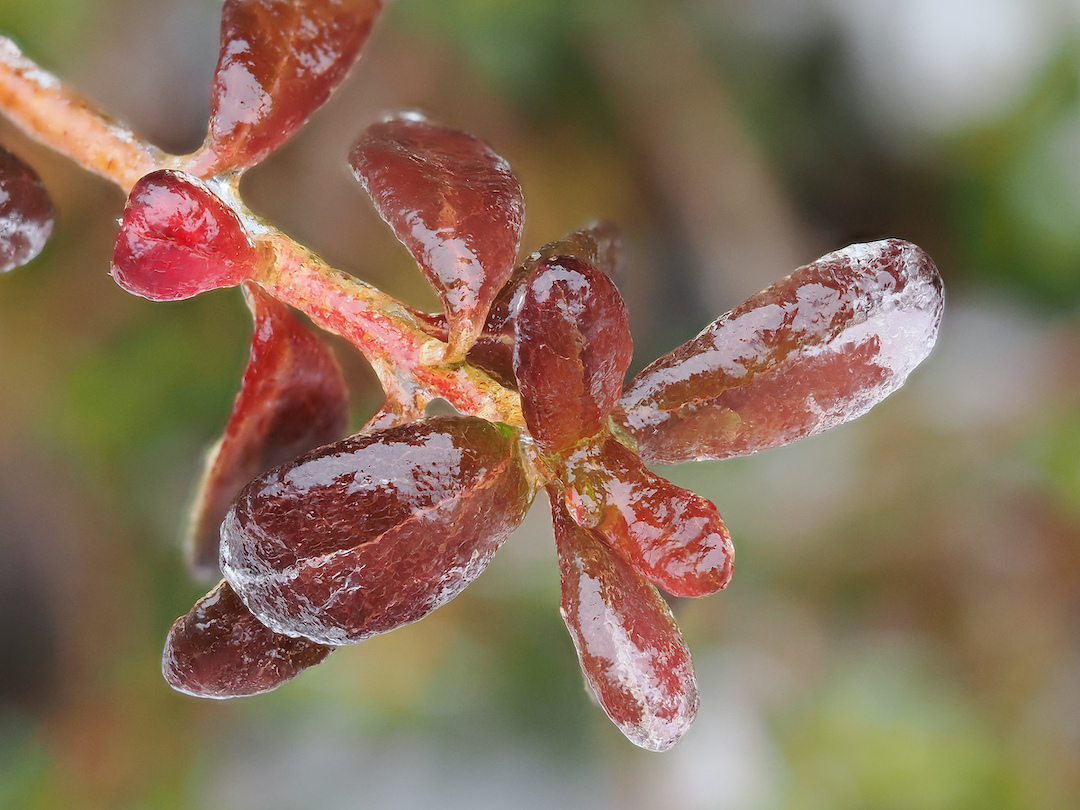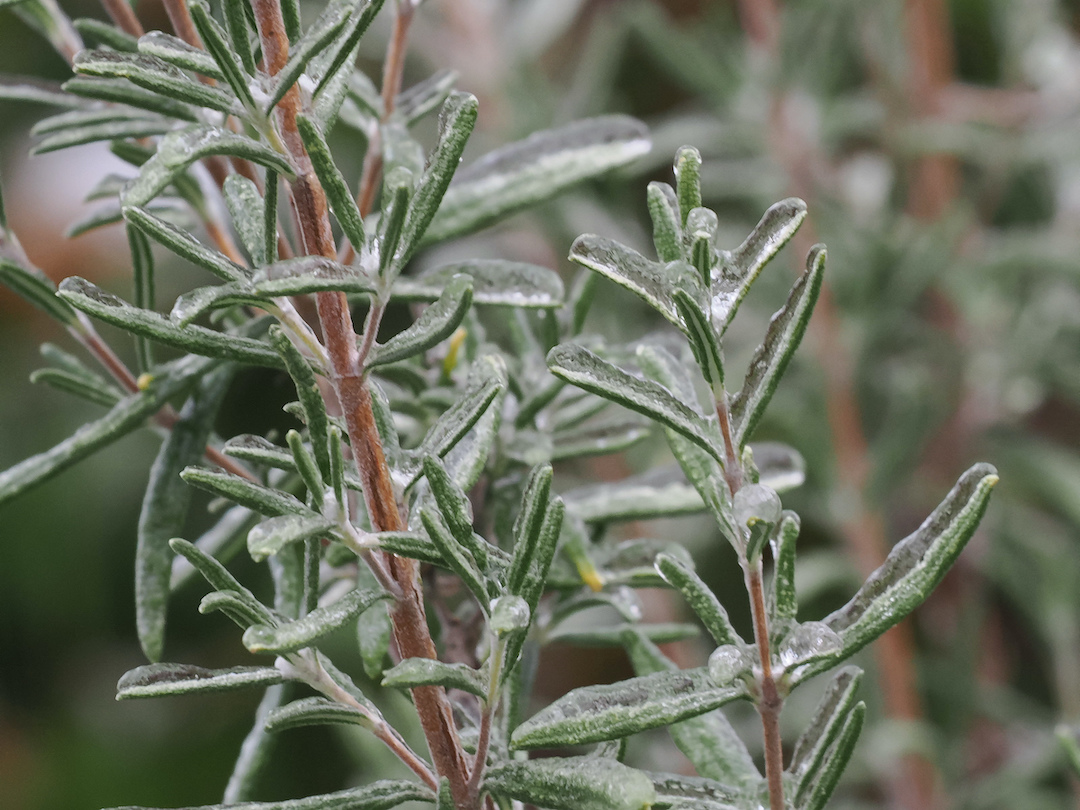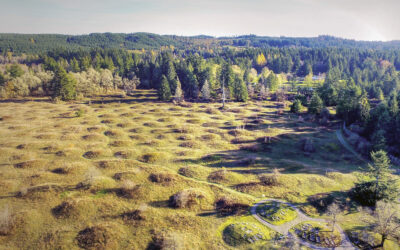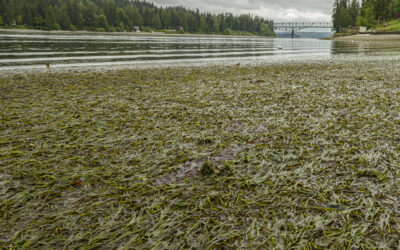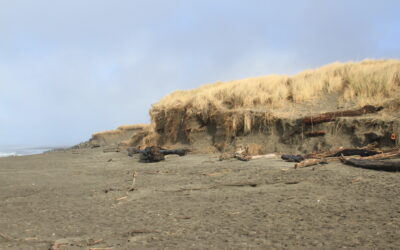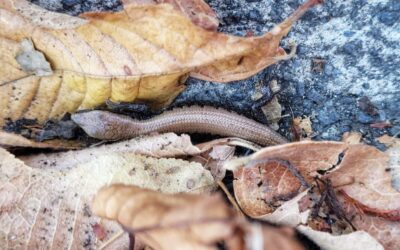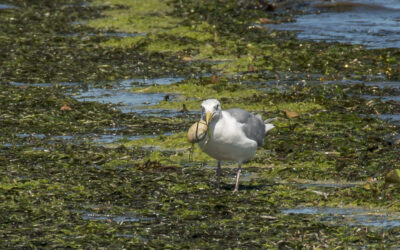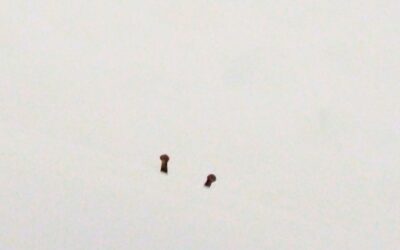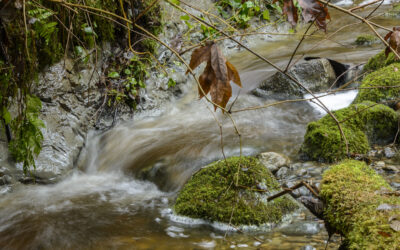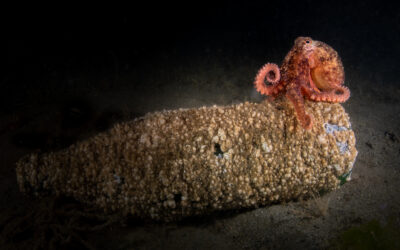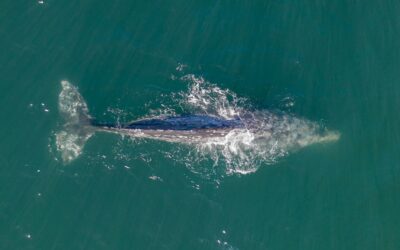PLANTS DON'T MOVE — OR DO THEY?
text and photos by John Bolivar, Spring 2023
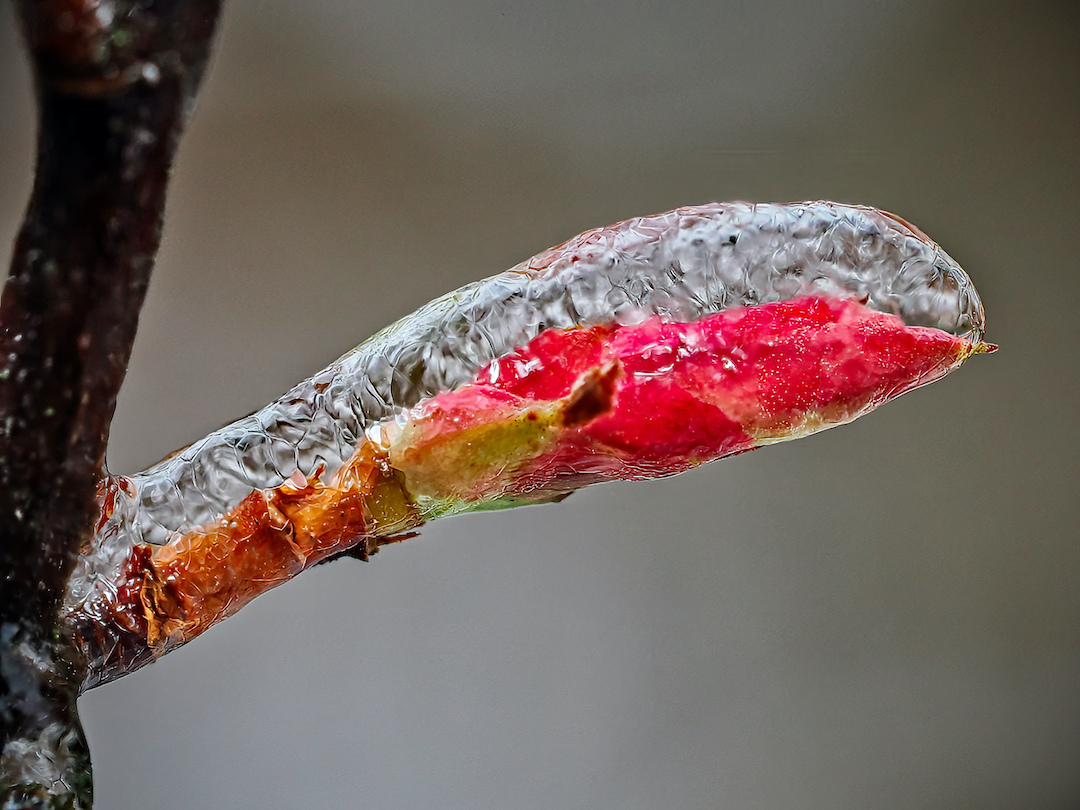
Ribes sanguineum floral bud encased in ice.
PLANTS DON'T MOVE — OR DO THEY?
text and photos by John Bolivar, Spring 2023
At first look it would appear that plants do not have the luxury of movement to help them avoid bad weather — like our recent bout of freezing rain that coated my garden plants with a thick layer of ice and sent our neighbor’s car careening down the hill. That was really slick ice!
Some plants can change the direction of their leaves or flowers but they can’t change locations; if they could, they might choose to live in a more favorable place. Imagine the botanical click bait: “Six best garden locations without invasive neighbors” or “The Top 10 Hot gardens for the Professional Cactus looking for a dry neighborhood to retire to.”
When the cold weather (or hot for that matter) comes, plants have to be able to withstand it, or they die. In winter, the sharp edges and spikes of ice crystals can be deadly to plants cells, which are soft and thin. The freezing of water within the cells can cause ice crystals to damage delicate cell walls and internal structures. In plants, that takes the form of dark leaf spots, mushy stems, and crinkled leaves — or worse yet — another visit to the nursery in the spring to buy an expensive replacement plant.
Luckily, many cold, hardy plants have developed adaptations that help them survive the cold. Many deciduous plants prepare for winter when their leaves change color and fall off, and the plant goes dormant — sleeping through winter’s dangerous cold weather before waking back up in the spring. Because the movement of water through the plant depends on the leaves, dormancy greatly reduces the possibility of the plant being damaged by cold, dry wind that would dry out the plant in the winter. Furthermore, frost damage to fragile leaves is eliminated. The plant’s cells have less water and as a result their cells contain higher concentrations of sugars, salts, and other organic compounds. This concentrated solution blocks water molecules from packing together when the temperature is lowered and thus lowers the temperature required to freeze the cells. This is the same concept that makes anti-freeze in a car radiator effective. The concentrated organic solution further reduces the chance that water in the cell will freeze and damage the plant cells.
Ice can also help plants survive freezing weather. In Florida I remember watching strawberry farmers coating their plants with water the day before a predicted hard freeze, so ice formed on the plants. I thought the water would freeze the plants and kill them, but actually it formed a protective blanket of ice on the plants so they would not lose too much moisture to the cold, desiccating winds. The ice also maintained a constant temperature around the strawberry plants that they could survive — albeit it was a cold 32 degrees (the temp of frozen water), but that is better than lethal lower temperatures. Sort of an icy protective blanket.
Other adaptations help the plants survive the cold as well. Seemingly delicate plant buds have outer scales that protect the interior bud from freezing or getting wind damage. Some trees, especially evergreens, are able to keep the fluids in their cells from freezing by moving the fluids within their cells around. They can move some of the water out of the cell to “extra-cellular” areas or spaces that are outside of the cells and avoid damage to the more fragile cell interiors.
So, plants do use movement to help them adapt to freezing weather after all. The movement just occurs within the plant itself. Thankfully they can’t just move in and snuggle up to us in front of the fire — mostly because my couch is already too crowded with my small slobbery dog.
John Bolivar has degrees in Botany and Photography. He has worked as a Wildlife Biologist in AK, and a sea kayak and mountain bike guide in Costa Rica, Belize, Baja, Canada and the PNW and traveled to over 42 countries to date. As an entrepreneur he started businesses in Seattle – Cuppa Jo On The Go coffee shop and Second Bounce Sporting goods.
His resume includes WebEditor at Canoe & Kayak Magazine and staff Medical Photographer at Virginia Mason Hospital. His photos have appeared in advertisements for REI, Patagonia, OR, Kavu, MSR, Cascade Designs and many top outdoor recreation companies. His freelance writing and photos have appeared in Sierra, Outside, Sea Kayaker, Popular Photography, Fortune and the NY Times.
He resides in Ballard with over 400 of his closest plant friends, AKA his garden, travels the world with his lovely tolerant wife, Jean and his old blind dog, Baxter. Most recently he can be seen wandering the state looking for rare native plants for the UW Rare Plant Monitoring Program and editing the digital newsletter for the WA Native Plant Society.
Table of Contents, Issue #19, Spring 2023
Underground Movement
by Amy Porter, Spring 2023 Wolf Haven mounded prairie. photo by Wolf Haven Internationalby Amy Porter, Spring 2023On Wolf Haven’s mounded prairie, there is an underground movement happening that largely goes unnoticed — bioturbation (the movement of soil) by Mazama...
A Window on Eelgrass
by Kylie Rench, Spring 2023 photos by John F. Williams by Kylie Rench, Spring 2023 photos by John F. WilliamsLow tide opens a window for the beach walker onto the vibrant world of eelgrass meadows. Submerged by salt water during most tidal cycles, these meadows are...
Poetry-19
Spring 2023 photo by Thomas NolandSpring 2023Sand and Water by Jeffrey Hummel Sand infinite amountsappearing all the sameBlowing, shifting, changingAbrasiveA handful you can’t holdSlides through your fingersGets into everythingevery part of youEvery nook, crack...
Lizard’s Locomotion
by Karin Kersteter, Spring 2023 illustrations by Karin Kersteter by Karin Kersteter, Spring 2023illustrations by Karin KersteterThere is an expression “leave the leaves,” which is designed to encourage people to let leaves lie in yards and gardens, rather than rake...
Turbulence
by Rebekah Boettcher, Spring 2023 photos by Rebekah Boettcher except as noted Seagull with clam. photo by John F. Williamsby Rebekah Boettcher, Spring 2023 photos by Rebekah Boettcher except as notedHow did I get here? I ponder, stunned once again as we walk down to...
Learning from a Snail’s Pace
by Michelle Ryder, Spring 2023 Photos by Michelle Ryder except as noted Mapfire peering over the side of the bathtub from inside of it.by Michelle Ryder, Spring 2023 Photos by Michelle Ryder except as notedIn 2022 a snail came into my life. And stayed. Late last...
Movement Imagery
Spring 2023 Cowling Creek, Suquamish. photo by John F. WilliamsSpring 2023Here is a collection of photos and art work depicting various kinds of movement. You may enjoy playing the audio file below as you view the photos. The music evokes the feeling of motion through...
2022 Photo Challenge
by MaST Center Aquarium, Spring 2023 Jurors' Favorite - On the Bottle, Veronika Nagy. Small octopus sitting on a bottle. by MaST Center Aquarium, Spring 2023The Underwater Photography Challenge focuses on bringing divers to Redondo Beach, Washington, to highlight the...
Gray Whales
by Laura Marx, Spring 2023 Gray whale off the Oregon coast. photo by Dan Meyers on Unsplash by Laura Marx, Spring 2023Gray whales and their amazing migrations up and down the west coast of the U.S. have made an impact in my life ever since I was a child. In the 1990’s...
PLEASE HELP SUPPORT
SALISH MAGAZINE
DONATE
Salish Magazine contains no advertising and is free. Your donation is one big way you can help us inspire people with stories about things that they can see outdoors in our Salish Sea region.
We also don't advertise Salish Magazine, so please spread the word of this online resource to your friends and colleagues.
Thanks so much for your interest and your support.
We also don't advertise Salish Magazine, so please spread the word of this online resource to your friends and colleagues.
Thanks so much for your interest and your support.

